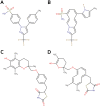A molecule perturbation software library and its application to study the effects of molecular design constraints
- PMID: 37752561
- PMCID: PMC10523775
- DOI: 10.1186/s13321-023-00761-5
A molecule perturbation software library and its application to study the effects of molecular design constraints
Abstract
Computational molecular design can yield chemically unreasonable compounds when performed carelessly. A popular strategy to mitigate this risk is mimicking reference chemistry. This is commonly achieved by restricting the way in which molecules are constructed or modified. While it is well established that such an approach helps in designing chemically appealing molecules, concerns about these restrictions impacting chemical space exploration negatively linger. In this work we present a software library for constrained graph-based molecule manipulation and showcase its functionality by developing a molecule generator. Said generator designs molecules mimicking reference chemical features of differing granularity. We find that restricting molecular construction lightly, beyond the usual positive effects on drug-likeness and synthesizability of designed molecules, provides guidance to optimization algorithms navigating chemical space. Nonetheless, restricting molecular construction excessively can indeed hinder effective chemical space exploration.
Keywords: Chemical space; Constraints; De novo molecule generation; Molecular design; Molecular fingerprints; RDKit; Software library; Topological perturbations.
© 2023. The Author(s).
Conflict of interest statement
The authors declare that they have no competing interests.
Figures













Similar articles
-
RetroGNN: Fast Estimation of Synthesizability for Virtual Screening and De Novo Design by Learning from Slow Retrosynthesis Software.J Chem Inf Model. 2022 May 23;62(10):2293-2300. doi: 10.1021/acs.jcim.1c01476. Epub 2022 Apr 22. J Chem Inf Model. 2022. PMID: 35452226 Review.
-
LEADD: Lamarckian evolutionary algorithm for de novo drug design.J Cheminform. 2022 Jan 15;14(1):3. doi: 10.1186/s13321-022-00582-y. J Cheminform. 2022. PMID: 35033209 Free PMC article.
-
FSM-DDTR: End-to-end feedback strategy for multi-objective De Novo drug design using transformers.Comput Biol Med. 2023 Sep;164:107285. doi: 10.1016/j.compbiomed.2023.107285. Epub 2023 Jul 31. Comput Biol Med. 2023. PMID: 37557054
-
Scaffold-Constrained Molecular Generation.J Chem Inf Model. 2020 Dec 28;60(12):5637-5646. doi: 10.1021/acs.jcim.0c01015. Epub 2020 Dec 10. J Chem Inf Model. 2020. PMID: 33301333
-
De Novo Molecule Design Using Molecular Generative Models Constrained by Ligand-Protein Interactions.J Chem Inf Model. 2022 Jul 25;62(14):3291-3306. doi: 10.1021/acs.jcim.2c00177. Epub 2022 Jul 6. J Chem Inf Model. 2022. PMID: 35793555 Review.
Cited by
-
Molecule auto-correction to facilitate molecular design.J Comput Aided Mol Des. 2024 Feb 16;38(1):10. doi: 10.1007/s10822-024-00549-1. J Comput Aided Mol Des. 2024. PMID: 38363377 Free PMC article.
References
Grants and funding
LinkOut - more resources
Full Text Sources

